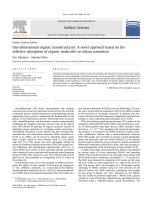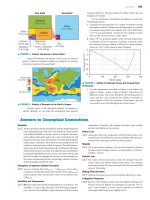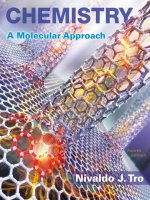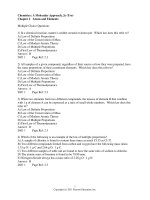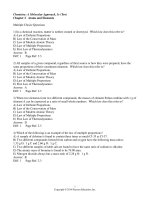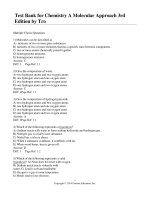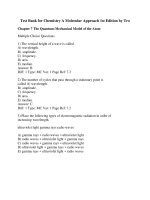Organic chemistry: a mechanistic approach
Bạn đang xem bản rút gọn của tài liệu. Xem và tải ngay bản đầy đủ của tài liệu tại đây (13.28 MB, 681 trang )
Organic
Chemistry
www.pdfgrip.com
Periodic Table of the Elements
1
18
1
2
H
He
helium
hydrogen
[1.008]
2
13
14
15
16
17
3
4
atomic number
5
6
7
8
9
Li
10
Be
Symbol
B
C
N
O
F
Ne
lithium
beryllium
carbon
nitrogen
oxygen
fluorine
neon
9.012
name
standard atomic weight
boron
[6.941]
[10.81]
[12.01]
[14.01]
[16.00]
19.00
20.18
11
12
13
14
15
16
17
18
Na
Mg
Al
Si
P
S
Cl
Ar
sodium
magnesium
4
5
6
7
8
9
10
11
12
silicon
phosphorus
sulfur
chlorine
argon
24.31
3
aluminium
22.99
26.98
[28.09]
30.97
[32.07]
[35.45]
39.95
19
20
21
22
23
24
25
26
27
28
29
30
31
32
33
34
35
36
K
Ca
Sc
Ti
V
Cr
Mn
Fe
Co
Ni
Cu
Zn
Ga
Ge
As
Se
Br
Kr
potassium
calcium
scandium
titanium
vanadium
chromium
manganese
iron
cobalt
nickel
copper
zinc
gallium
germanium
arsenic
selenium
bromine
krypton
39.10
40.08
44.96
47.87
50.94
52.00
54.94
55.85
58.93
58.69
63.55
65.38(2)
69.72
72.63
74.92
78.96(3)
79.90
83.80
37
38
39
40
41
42
43
44
45
46
47
48
49
50
51
52
53
54
Rb
Sr
Y
Zr
Nb
Mo
Tc
Ru
Rh
Pd
Ag
Cd
In
Sn
Sb
Te
I
Xe
rubidium
strontium
yttrium
zirconium
niobium
molybdenum
technetium
ruthenium
rhodium
palladium
silver
cadmium
indium
tin
antimony
tellurium
iodine
xenon
85.47
87.62
88.91
91.22
92.91
95.96(2)
[99]
101.1
102.9
106.4
107.9
112.4
114.8
118.7
121.8
127.6
126.9
131.3
55
56
57-71
72
73
74
75
76
77
78
79
80
81
82
83
84
85
86
Cs
Ba
lanthanoids
Hf
Ta
W
Re
Os
Ir
Pt
Au
Hg
Tl
Pb
Bi
Po
At
Rn
caesium
barium
hafnium
tantalum
tungsten
rhenium
osmium
iridium
platinum
gold
mercury
thallium
lead
bismuth
polonium
astatine
radon
132.9
137.3
178.5
180.9
183.8
186.2
190.2
192.2
195.1
197.0
200.6
[204.4]
207.2
209.0
[210]
[210]
[222]
87
88
89-103
104
105
106
107
108
109
110
111
112
actinoids
Key:
114
116
Fr
Ra
Rf
Db
Sg
Bh
Hs
Mt
Ds
Rg
Cn
Fl
Lv
francium
radium
rutherfordium
dubnium
seaborgium
bohrium
hassium
meitnerium
darmstadtium
roentgenium
copernicium
flerovium
livermorium
[223]
[226]
[267]
[268]
[271]
[272]
[277]
[276]
[281]
[280]
[285]
57
58
59
60
61
62
63
64
65
66
67
68
69
70
71
La
Ce
Pr
Nd
Pm
Sm
Eu
Gd
Tb
Dy
Ho
Er
Tm
Yb
Lu
lanthanum
cerium
praseodymium
neodymium
promethium
samarium
europium
gadolinium
terbium
dysprosium
holmium
erbium
thulium
ytterbium
lutetium
138.9
140.1
140.9
144.2
[145]
150.4
152.0
157.3
158.9
162.5
164.9
167.3
168.9
173.1
175.0
89
90
91
92
93
94
95
96
97
98
99
100
101
102
103
Ac
Th
Pa
U
Np
Pu
Am
Cm
Bk
Cf
Es
Fm
Md
No
Lr
actinium
thorium
protactinium
uranium
neptunium
plutonium
americium
curium
berkelium
californium
einsteinium
fermium
mendelevium
nobelium
lawrencium
[227]
232.0
231.0
238.0
[237]
[239]
[243]
[247]
[247]
[252]
[252]
[257]
[258]
[259]
[262]
Notes
The uncertainty of an atomic weight value is ±1 in the last digit unless a different value is given in parentheses. No values are given
for elements which have no natural stable isotopes; for such elements, a mass number of a typical radioisotope is given in parentheses.
www.pdfgrip.com
4.003
Organic
Chemistry
a mechanistic approach
Tadashi O
Okuyama
Professsor Emeritus,
Professor
University of Hyogo, Japan
Howard
Howa
ard Maskill
Visitting Professor,
Visiting
Department of Chemical and
Biolog
Biological Sciences,
University of Huddersfi
Hu
eld, UK
1
www.pdfgrip.com
1
Great Clarendon Street, Oxford, OX2 6DP,
United Kingdom
Oxford University Press is a department of the University of Oxford.
It furthers the University’s objective of excellence in research, scholarship,
and education by publishing worldwide. Oxford is a registered trade mark of
Oxford University Press in the UK and in certain other countries
© Tadashi Okuyama and Howard Maskill 2014
The moral rights of the authors have been asserted
Impression: 1
Japanese version published by Maruzen Publishing Co., Ltd., Japan
© Tadashi Okuyama 2008.
All rights reserved. No part of this publication may be reproduced, stored in
a retrieval system, or transmitted, in any form or by any means, without the
prior permission in writing of Oxford University Press, or as expressly permitted
by law, by licence or under terms agreed with the appropriate reprographics
rights organization. Enquiries concerning reproduction outside the scope of the
above should be sent to the Rights Department, Oxford University Press, at the
address above
You must not circulate this work in any other form
and you must impose this same condition on any acquirer
British Library Cataloguing in Publication Data
Data available
ISBN 978–0–19–969327–6
Printed in China by
C&C Offset Printing Co. Ltd
Links to third party websites are provided by Oxford in good faith and
for information only. Oxford disclaims any responsibility for the materials
contained in any third party website referenced in this work.
www.pdfgrip.com
Foreword
Organic chemistry deals with the structures, synthesis, and functions of compounds whose molecules
now include assemblies up to giant biomolecules such as nucleic acids, proteins, and polysaccharides.
Because so many life processes are regulated by interactions between small organic molecules and gigantic biomolecules, James Watson, the 1962 Nobel Laureate in Physiology and Medicine, was able to say
‘Life is simply a matter of chemistry’. It follows that organic chemistry applied to biological science is the
basis of life science. Current organic chemistry is also central to burgeoning new areas of materials science whose applications extend to industrial products which support our daily lives. And, just as organic
chemistry continues to develop, the way in which it is taught must adapt and, especially, use all the aids
presently available to support the learning process.
By developing an appreciation of how organic reactions take place based on orbital interactions and
electron flow, this book allows known reactions to be understood and new ones to be predicted. The book
is organized in a manner which will facilitate the transition from high school chemistry to university
level organic chemistry, and provides insights into some currently developing areas. In particular, the
authors clearly present underlying principles and show how these bring order and logic to the subject.
Ryoji Noyori, 2013
www.pdfgrip.com
Preface
Organic chemistry is a mature branch of science which continues to expand in the sense that new reactions and new compounds continue to be discovered. Some compounds newly isolated from natural
sources support life; others, synthesized in the laboratory, are unknown in nature but have led to advances
in medicine and other areas of science and technology. A consequence of the huge and increasing number
of known organic compounds is that any chemist can have book-knowledge of only a tiny fraction and
practical experience of an even smaller number. However, a molecule of an organic compound may generally be seen as a functional group bonded to a hydrocarbon residue and organic chemistry is essentially
the chemistry of a relatively small number of functional groups. Consequently, comprehension of organic
chemistry as a whole is achievable from knowledge of the characteristic reactions of functional groups
and an understanding of how they occur, i.e. their mechanisms.
The Approach of this Book
There are different approaches to the teaching of organic chemistry at university level. In this book, we
begin with a review of atomic and molecular structure and then look at factors which determine the
shapes of molecules. Next, we cover acid–base (proton transfer) reactions since these are distinctive
features of many reactions of organic compounds, especially ones of biological importance including
reactions catalysed by enzymes. We then show that all overall reactions of organic compounds belong to
one of a relatively small number of classes of reaction types. Moreover, when we introduce the concept of
mechanism in organic chemistry, and look at how reactions take place, we see that only a small number
of types of elementary steps are involved.
When features common to all organic reactions have been covered, we proceed to look at reactions of
individual functional groups. Our approach, based upon a survey of teachers of organic chemistry in over
50 colleges and universities in Japan and guided by nine reviewers from different parts of Europe and
North America, is to focus on underlying mechanistic principles as the unifying basis of organic chemistry. The outcome is a concise non-mathematical text which introduces molecular orbital considerations
early on and uses ‘curly arrows’ (as appropriate) to describe mechanisms throughout. The book is not
intended to be an encyclopaedic reference text of organic chemistry; it is a learning-and-teaching text
and the coverage broadly corresponds to the organic chemistry syllabus of a typical honours degree in
chemistry at a British university. However, we include connections to biological sciences wherever they
are relevant to emphasize that organic chemistry is the basis of life science. To supplement the core chemistry, we have also included ‘panels’ containing material (sometimes topical) which relate the chemistry
to current everyday life and biological phenomena. Consequently, depending on the level to which the
subject is to be taught, the book could be appropriate for students of health sciences and technology, as
well as premedical students.
Learning from this Book
To assist students, worked examples and exercises are embedded within each chapter; answers to inchapter exercises are provided on the book’s web site, which we describe further below. Each chapter also
has a summary together with additional problems at the end. In addition, we include an early section on
organic nomenclature, appendices which contain reference data, and flow charts encapsulating reactions
and interconversions of functional groups, and a comprehensive index.
www.pdfgrip.com
Preface . . . vii
Online Support
Organic Chemistry: a mechanistic approach is accompanied by a website that features study and teaching aids.
For students:
• Answers to in-chapter exercises
• 3D-rotatable models of numerous compounds featured in the book
• Multiple-choice questions for each chapter to help you check your understanding of topics you have
learned
For lecturers:
• Figures from the book in electronic format
• Answers to end-of-chapter problems
• Examples of organic synthesis reactions, related to topics covered in the book, for use in teaching
• Additional problems (with answers), to supplement those included in the book
To find out more, go to www.oxfordtextbooks.co.uk/orc/okuyama/.
You can also explore organic reaction mechanisms at www.chemtube3d.com. This site provides a wide
range of interactive 3D animations of some of the most important organic reactions you are likely to
encounter during your studies.
Acknowledgements
This book is based on the Japanese text, Organic Chemistry (Maruzen Publishing Co., Ltd., Tokyo, 2008)
by a group of authors including one of us. We are very grateful to the other coauthors of that book,
especially Professors Mao Minoura and Hiroshi Yamataka (Rikkyo University), Akihiko Ishii (Saitama
University), and Takashi Sugimura (University of Hyogo), for their help during our work on this book.
We are also grateful to Dr Ryohei Kishi (Osaka University) for his assistance in the preparation of some of
the molecular orbital diagrams, and to the editorial staff at OUP, especially Jonathan Crowe. In spite of all
the help we have received, there will be residual errors in a book of this length; we welcome assistance
in rooting out mistakes of any sort and will post corrections on the above mentioned website. Finally, we
acknowledge with appreciation that this book could not have been completed without the forbearance
and support of our wives.
www.pdfgrip.com
A Note to Students
Some students occasionally find organic chemistry a formidable subject involving the memorization of
an overwhelming number of compounds and their reactions. However, as we mention in the preface,
organic compounds fall into a small number of classes characterized by the functional groups at which
reactions take place; similarly, there is only a limited number of reaction types classified according to
their mechanisms. Consequently, systematic learning of relatively few mechanisms brings order and
logic to organic chemistry, and will allow you to appreciate the subject in all its glorious and fascinating
diversity. This text, Organic Chemistry: a mechanistic approach, has been written to guide you along
this path.
An organic chemical reaction—the transformation of one compound into another—is described in
terms of the structures of compounds involved, and the reactivity of a compound (how it reacts and
whether the reaction will be fast or slow) is determined by its structure (and the reaction conditions).
How a reaction is believed to occur, i.e. its reaction mechanism, is nowadays represented by curly arrows
describing the movement of electrons, and we use mechanistic schemes throughout this book. Usually,
the schemes will show not just how the reaction occurs but why it occurs in the way shown, and why it
is favourable. Our pictorial reaction schemes with structures of compounds and curly arrows showing
how they react contain a lot of information. We have used several devices to assist their interpretation,
including colour and annotations.
The following two schemes taken from the text illustrate some conventions in this book to describe
reaction mechanisms. Some boxes contain text to indicate what facilitates a particular step, i.e. why it
is favourable, and bonds newly formed in each step; text in other boxes identifies types of groups, e.g.
nucleophile or electrophile. Coloured text under reaction arrows identifies the type of reaction which
may be a single step (e.g. proton transfer) or an overall transformation (e.g. substitution). Text under a
chemical species indicates its nature, e.g. an intermediate. Note that all steps in these two schemes are
reversible in principle but, by including one arrow in the final step of the second scheme in parentheses,
for example, we identify a step as being essentially unidirectional because of the reaction conditions and/
or the equilibrium constant.
driving force
(electron pull)
+
H
O
H
pull
O
H
R
OR'
pr oton
transf er
R
+
O
new bond
H
H
H
+
O
HO
O
H
OH2
H
OR'
R
HO
OH
OR'
+ H3O+
pr oton
R
OR'
transf er
tetrahedral intermediate
driving force
(electron push)
push
new bond
nucleophile
O
–
HO
HO
O
O
–
R
R
R
OR'
leaving group
addition
OR'
RCO2–
OH
–
+ OR'
elimination
substitution (hydrolysis)
www.pdfgrip.com
pr oton
transf er
+ R'OH
A Note to Students . . . ix
It is important that you can draw clearly in two dimensions organic structures which are generally
three-dimensional. To do this, practice with pencil and paper is essential. In addition, you have to learn
to use curly arrows to describe the movement of electrons corresponding to a reaction, i.e. bond breaking
and bond making steps. Remember that organic chemistry can be communicated by drawing structures
of molecules and curly arrow reaction mechanisms—it is as though we have a language with structures
and mechanisms as the vocabulary and grammar; and, as with learning a language, fluency develops with
practice.
Worked examples are embedded in the text to review what has just been covered and illustrate how to
solve exercises and problems within and at the ends of chapters, respectively. In later chapters, we also
have ‘supplementary problems’ which are a little more difficult and may relate to material in previous
chapters. It will be most beneficial if you attempt exercises and problems without looking at the solutions
first, even though they are available on the website associated with the book. If you find that you cannot
do an exercise or problem, go back to the text to review the material upon which the exercise or problem
is based, then try again. This iterative process is an important aspect of learning organic chemistry and
will help you to learn how to solve problems generally (rather than just memorize facts). When you arrive
at a reasonable answer, check it against the solution provided. However, note that there may be different
ways of approaching some problems (and some may have more than a single correct answer); but when
you are really stuck, always seek advice.
One final point: the names of chemists crop up from time to time throughout the book; they are usually
eminent chemists who have made significant contributions to organic chemistry (which is, after all, an
area of human endeavour) and their portraits are shown. Sometimes, reactions have been named after
them. Although the use of chemists’ names is a long-standing and often helpful short-hand way of referring to reactions and well-established empirical rules or general principles, knowing and understanding
the chemistry involved is more important than remembering the names.
www.pdfgrip.com
Abbreviations
Entry
Full name
acetyl
adenosine diphosphate
azobisisobutyronitrile
atomic orbital
aryl
adenosine triphosphate
butylated hydroxyanisole
butylated hydroxytoluene
2,2′-bis(diphenylphosphino)-1,1′binaphthyl
Bn
benzyl
Boc
t-butoxycarbonyl
bp
boiling point
BPO
dibenzoyl peroxide
Bu
butyl
Bz
benzoyl
Cbz
benzyloxycarbonyl
CIP
Cahn–Ingold–Prelog
CoA, CoASH coenzyme A
DBN
1,5-diazabicyclo[4.3.0]non-5-ene
DBU
1,8-diazabicyclo[5.4.0]undec-7-ene
DCC
N,N-dicyclohexylcarbodiimide
DEAD
diethyl azodicarboxylate
DMAP
4-dimethylaminopyridine
DMF
N,N-dimethylformamide
DMSO
dimethyl sulfoxide
DNA
deoxyribonucleic acid
DOMO
doubly occupied molecular orbital
E.A.
electron affinity
E1
unimolecular elimination
E1cB
unimolecular elimination via
conjugate base
E2
bimolecular elimination
EDG
electron-donating group
ee
enantiomeric excess
EPM
electrostatic potential map
Et
ethyl
EWG
electron-withdrawing group
FGI
functional group interconversion
Fmoc
fluorenylmethoxycarbonyl
GC
gas chromatography
HOMO
highest occupied molecular orbital
HPLC
high performance liquid
chromatography
I.E.
ionization energy, ionization
potential
Ac
ADP
AIBN
AO
Ar
ATP
BHA
BHT
BINAP
Entry
Full name
i-Pr
IR
IUPAC
isopropyl
infrared
International Union of Pure and
Applied Chemistry
lithium diisopropylamide
lowest unoccupied molecular orbital
m-chloroperoxybenzoic acid
methyl
molecular orbital
melting point
mass spectrometry
nicotinamide adenine dinucleotide
reduced form of NAD
N-bromosuccinimide
neighbouring group participation
N-methylformamide
nuclear magnetic resonance
nuclear Overhauser effect
optical purity
pyridinium chlorochromate
poly(ethylene terephthalate)
prostaglandin
phenyl
propyl
phase transfer catalysis
pyridine
radio frequency
ribonucleic acid
S-adenosylmethionine
single electron transfer
unimolecular nucleophilic
substitution
bimolecular nucleophilic substitution
nucleophilic substitution, internal
singly occupied molecular orbital
tetrahydrofuran
tetrahydropyranyl
t-butyldimethylsilyl
t-butyl
tetramethylsilane
triphenylmethyl (trityl)
transition state, transition structure
p-toluenesulfonyl (tosyl)
unoccupied molecular orbital
ultraviolet
valence shell electron pair repulsion
LDA
LUMO
MCPBA
Me
MO
mp
MS
NAD+
NADH
NBS
n.g.p.
NMF
NMR
NOE
O.P.
PCC
PET
PG
Ph
Pr
PTC
py
rf
RNA
SAM
SET
SN1
SN2
SNi
SOMO
THF
THP
TBS
t-Bu
TMS
Tr
TS
Ts
UMO
UV
VSEPR
www.pdfgrip.com
Overview of Contents
Foreword
Preface
A Note to Students
v
vi
viii
Abbreviations
Prologue: The History and Scope of Organic Chemistry
x
xxvi
Chapter 1 Atoms, Molecules, and Chemical Bonding—a Review
1
Chapter 2 Molecular Structure and Shapes of Organic Molecules
22
Chapter 3 Organic Compounds: their Functional Groups, Intermolecular
Interactions, and Physical Properties
42
Chapter 4 Conformation and Strain in Molecules
71
Chapter 5 Conjugation, π-Electron Delocalization, and Aromaticity
89
Chapter 6 Acids and Bases
110
Chapter 7 Organic Reactions and the Concept of Mechanism
138
Chapter 8 Nucleophilic Addition to the Carbonyl Group in Aldehydes and Ketones
165
Chapter 9 Nucleophilic Substitution Reactions of Carboxylic Acid Derivatives
188
Chapter 10 Reactions of Carbonyl Compounds with Hydride Donors and
Organometallic Reagents
208
Chapter 11 Stereochemistry and Molecular Chirality
225
Chapter 12 Nucleophilic Substitution Reactions of Haloalkanes
and Related Compounds
250
Chapter 13 Elimination Reactions of Haloalkanes and Related Compounds
273
Chapter 14 Reactions of Alcohols, Ethers, Thiols, Sulfides, and Amines
289
Chapter 15 Addition Reactions of Alkenes and Alkynes
314
Chapter 16 Electrophilic Aromatic Substitution
341
Chapter 17 Enolate Ions, their Equivalents, and Reactions
373
Chapter 18 Reactions of Nucleophiles with Alkenes and Aromatic Compounds
402
Chapter 19 Polycyclic and Heterocyclic Aromatic Compounds
423
Chapter 20 Reactions involving Radicals
444
www.pdfgrip.com
xii . . . Overview of Contents
Chapter 21 Pericyclic Reactions: Cycloadditions, Electrocyclic Reactions,
and Sigmatropic Rearrangements
469
Chapter 22 Rearrangement Reactions involving Polar Molecules and Ions
490
Chapter 23 Organic Synthesis
506
Chapter 24 Chemistry of Biomolecules
528
Chapter 25 Structural Determination of Organic Compounds
561
Appendices
Additional Resources
Index
602
617
619
www.pdfgrip.com
Contents in Detail
Foreword
Preface
A Note to Students
v
vi
viii
Abbreviations
Prologue: The History and Scope of Organic Chemistry
Chapter 1 Atoms, Molecules, and Chemical Bonding—a Review
The Electronic Structure of Atoms
1.1.1 Atomic structure
1.1.2 Electrons and atomic orbitals
Panel 1.1 Radiocarbon dating
1.1.3 Electronic configuration of an atom
1.1.4 Lewis representation of atoms
1.2 Chemical Bonding
1.2.1 Formation of ions
1.2.2 Ionic and covalent bonds
1.2.3 Polar covalent bonds and dipoles
Panel 1.2 Masses and sizes of atoms
1.3 Lewis Structures of Molecules and Ions
1.3.1 How to draw Lewis structures
1.3.2 Further examples of drawing Lewis structures
1.4 Introduction to Resonance
Summary
Problems
1.1
Chapter 2 Molecular Structure and Shapes of Organic Molecules
Shapes of Molecules and the VSEPR Model
2.1.1 Tetrahedral shapes
2.1.2 Trigonal planar shapes
2.1.3 Linear shapes
2.2 Orbital Description of Covalent Bonding
2.2.1 Atomic orbitals and their shapes
2.2.2 Overlap of atomic orbitals to give molecular orbitals
2.3 Hybridization of Atomic Orbitals
2.3.1 Three types of hybrid orbitals
Panel 2.1 The work of Linus Pauling
2.3.2 Energies of hybrid orbitals
2.4 Bonding in Methane
2.5 Bonding in Ethene
2.5.1 Trigonal planar carbons
2.5.2 The pi (π) orbitals
2.6 Bonding in Ethyne
2.7 Hybridization of Carbon and Bond Lengths
2.8 Drawing Organic Structures
2.9 Isomerism
2.1
www.pdfgrip.com
x
xxvi
1
1
1
2
3
4
6
6
6
8
10
12
12
12
15
18
20
20
22
22
22
24
24
25
25
27
28
28
28
29
30
31
31
31
33
35
35
37
xiv . . . Contents in Detail
2.9.1
2.9.2
2.9.3
Summary
Problems
Constitutional isomers
cis–trans isomerism
E,Z nomenclature for cis–trans isomers of alkenes
Chapter 3 Organic Compounds: their Functional Groups,
Intermolecular Interactions, and Physical Properties
Functional Groups
Hydrocarbons
3.2.1 Alkanes and cycloalkanes
Panel 3.1 Organic resources: coal, oil, and natural gas
3.2.2 Alkenes and alkynes
Panel 3.2 Ethene as an industrial raw material
3.2.3 Arenes
3.3 Alcohols, Ethers, and their Sulfur Analogues
3.3.1 Alcohols
3.3.2 Ethers
3.3.3 Thiols
3.4 Haloalkanes
3.5 Nitrogen Compounds
3.5.1 Amines
3.5.2 Nitro compounds
3.6 Aldehydes and Ketones
3.7 Carboxylic Acids and their Derivatives
3.8 Elements of Organic Nomenclature
3.8.1 IUPAC nomenclature
3.8.2 Naming a non-aromatic hydrocarbon
3.8.3 Naming a compound with one or more functional groups
3.8.4 Naming aromatic compounds
3.9 Intermolecular Interactions and Physical Properties of Organic Compounds
3.9.1 van der Waals forces
3.9.2 Hydrogen bonds
3.9.3 States of matter and phase changes
3.9.4 Boiling points of organic compounds
3.9.5 Solubility
Panel 3.3 Chromatography
Summary
Problems
3.1
3.2
37
37
38
40
40
42
42
43
43
46
49
49
50
50
51
52
52
52
53
53
54
54
55
56
56
57
58
60
61
61
62
63
63
65
66
68
69
Chapter 4 Conformation and Strain in Molecules
71
Molecular Vibrations and Internal Rotation
4.1.1 Bond stretching and bending vibrations
4.1.2 Internal rotation
4.2 Conformations of Alkanes
4.2.1 Ethane and torsional strain
4.2.2 Butane and steric strain
4.3 Cycloalkanes
4.3.1 Cyclopropane and angle strain
4.3.2 Cyclobutane and cyclopentane
4.3.3 Cyclohexane: chair conformations
Panel 4.1 Heterocyclic chair compounds: tetrodotoxin
71
71
72
72
72
76
77
77
78
79
82
4.1
www.pdfgrip.com
Contents in Detail . . . xv
4.3.4 Cyclohexane: ring inversion of chair conformations
4.4 Disubstituted Cycloalkanes: cis–trans Isomerism
4.5 Strain in Cycloalkanes: Heat of Combustion
Panel 4.2 Bicycloalkanes
Summary
Problems
Chapter 5 Conjugation, π-Electron Delocalization, and Aromaticity
Extended π Bonds and the Concept of Conjugation
Bonding in Butadiene
Allylic Systems
5.3.1 Molecular orbitals of allylic systems
5.3.2 Resonance description of allylic systems
5.3.3 Allyl anion analogues
5.4 Resonance Revisited
5.4.1 The nature of resonance
5.4.2 Resonance forms and their relative contributions
5.5 Benzene
5.5.1 Structure of benzene
5.5.2 Molecular orbitals of benzene
5.5.3 Stabilization energy of benzene
Panel 5.1 The structure of benzene and Kekulé’s dreams
5.6 Aromaticity in General
5.6.1 Hückel’s rule
5.6.2 Annulenes
5.7 Photoexcited Organic Molecules
5.7.1 Interactions of organic molecules with electromagnetic radiation
5.7.2 Properties of photoexcited states
Panel 5.2 The perception of colours
5.7.3 Photochemical reactions
Panel 5.3 The chemistry of vision
Summary
Problems
5.1
5.2
5.3
Chapter 6 Acids and Bases
82
84
85
86
87
87
89
90
90
92
92
93
94
95
95
95
98
98
98
99
100
100
100
104
104
104
105
106
106
107
108
108
110
Definitions of Acids and Bases
6.1.1 Brønsted acids and bases
6.1.2 Lewis acids and bases
6.2 Equilibrium in Brønsted Acid–Base Reactions
6.2.1 Acid dissociation constants and pKa
Panel 6.1 pKa values for water and the oxonium ion
6.2.2 Equilibrium in acid–base reactions
6.2.3 Acidity of aqueous solutions and ratios of conjugate acid–base pairs
6.2.4 Buffer solutions
Panel 6.2 pH indicators and colours of flowers
6.3 Factors which affect the Strength of an Acid
6.3.1 The element bearing the acidic hydrogen
6.3.2 Charge delocalization in anions
6.3.3 Substituent effects
6.4 Carbon Acids and Carbanions
6.4.1 Hydrocarbons
6.4.2 Effects of electron-withdrawing groups on C–H acidity
6.1
www.pdfgrip.com
111
111
112
113
114
115
115
117
118
119
120
120
121
122
124
124
127
xvi . . . Contents in Detail
Basicity of Organic Compounds
6.5.1 Definition of base strengths
6.5.2 Nitrogen bases
6.5.3 Weakly basic organic compounds
6.6 Polyfunctional Acids and Bases
6.7 Solvent Effects on Acid–Base Reactions
6.7.1 The levelling effect of water
Panel 6.3 Extraction of morphine from opium
6.7.2 Acid–base reactions in non-aqueous solvents
Summary
Problems
6.5
Chapter 7 Organic Reactions and the Concept of Mechanism
Classes of Organic Chemical Reactions
Elementary Steps in a Chemical Reaction
7.2.1 Homolysis
7.2.2 Heterolysis
7.2.3 Concerted bond formation and cleavage in an elementary reaction
7.2.4 The transition structure in a concerted elementary reaction
7.2.5 Site of nucleophilic attack at a cationic electrophile
7.2.6 Sigma and pi bonds as nucleophilic centres
7.3 A Molecular Orbital Description of Polar Elementary Reactions
7.3.1 Orbital interactions in bimolecular elementary reactions
7.3.2 HOMO–LUMO interactions
7.3.3 Orbital overlap and orientation
7.4 Reaction Energetics, Reaction Profiles, and Equilibria
7.4.1 Energy change for a one-step reaction of a single molecule
7.4.2 From reaction of a single molecule to reaction on a molar scale
Panel 7.1 Reaction profiles for unimolecular bond-cleavage elementary reactions
7.4.3 Gibbs energy reaction profiles
7.4.4 Profiles of multistep reactions
7.4.5 Equilibrium constant
7.5 Characterization of Organic Reactions and Investigation of their Mechanisms
7.5.1 Product studies and mechanistic proposals
Panel 7.2 The Hammond postulate
7.5.2 Detection of intermediates in stepwise mechanisms
7.5.3 The rate law as an indicator of mechanism
7.5.4 Effect of substrate structure and reaction conditions on rate constants
Summary
Problems
7.1
7.2
Chapter 8 Nucleophilic Addition to the Carbonyl Group in Aldehydes and Ketones
8.1 Polarity of the Carbonyl Bond
Panel 8.1 Common carbonyl compounds: methanal, ethanal, and propanone
8.2 Formation of Cyanohydrins
8.3 Addition of Water to Aldehydes and Ketones
8.3.1 Hydration equilibrium
8.3.2 The mechanism of hydration of carbonyl compounds and catalysis
8.3.3 Reversibility of hydration and oxygen isotope exchange
8.4 Addition of Alcohols to Aldehydes and Ketones
8.4.1 Formation of hemiacetals
8.4.2 Formation of acetals
www.pdfgrip.com
129
129
129
130
131
133
133
134
135
136
136
138
138
140
140
141
143
144
145
146
147
147
148
149
150
150
150
151
152
153
155
156
156
157
158
159
160
161
162
165
166
168
169
171
171
173
175
176
176
177
Contents in Detail . . . xvii
8.4.3 Addition of thiols
Addition of Bisulfite to Aldehydes and Ketones
Imines and Enamines
8.6.1 Reactions of primary amines with aldehydes and ketones
8.6.2 Reactions of secondary amines with aldehydes and ketones
8.7 The Wittig Reaction
Panel 8.2 Imines in biochemical reactions
Summary
Problems
8.5
8.6
180
180
181
181
183
183
184
185
186
Chapter 9 Nucleophilic Substitution Reactions of Carboxylic Acid Derivatives
188
9.1 Reactions of Carboxylic Acid Derivatives
Panel 9.1 Common names of carboxylic acids
9.2 Hydrolysis of Esters
9.2.1 Hydration of the carbonyl group
9.2.2 Reaction under alkaline conditions
9.2.3 Acid-catalysed hydrolysis
9.2.4 Evidence for a tetrahedral intermediate
9.3 Other Reactions of Esters
9.3.1 Ester exchange reactions
9.3.2 Reactions of esters with amines
9.4 Generalized Nucleophilic Addition–Elimination Reactions
9.4.1 Reaction mechanism
9.4.2 Relative reactivities of carboxylic acid derivatives
9.4.3 Comparison of reactions of nucleophiles with carboxylic acid derivatives
and with aldehydes and ketones
9.5 Interconversion of Carboxylic Acid Derivatives
9.5.1 Acyl chlorides
9.5.2 Acid anhydrides
9.5.3 Amides
9.5.4 Carboxylic acids
Panel 9.2 Lactones and lactams
9.5.5 Summary of relative reactivities
9.6 Polycondensation
Panel 9.3 Recycling of PET
Summary
Problems
189
189
190
190
190
192
193
195
195
195
196
196
197
Chapter 10 Reactions of Carbonyl Compounds with Hydride Donors and
Organometallic Reagents
10.1 Hydride Reduction of Carbonyl Groups
10.1.1 Reduction of aldehydes and ketones
Panel 10.1 Bonding in BH 4–
10.1.2 Reduction of carboxylic acid derivatives
10.2 Indirect Reduction of Aldehydes and Ketones
10.2.1 Reductive amination
10.2.2 Reduction of the C=O of aldehydes and ketones to give CH2
10.3 Hydride Transfer from Carbon
Panel 10.2 The Meerwein–Ponndorf–Verley–Oppenauer reaction
Panel 10.3 Nature's hydride donor: NADH
10.4 Reactions with Organometallic Reagents: C–C Bond Formation
10.4.1 Organometallic compounds
www.pdfgrip.com
198
199
199
200
201
201
202
203
203
204
205
206
208
208
208
209
210
211
212
212
213
214
215
215
215
xviii . . . Contents in Detail
10.4.2 The Grignard reaction
10.4.3 Side reactions with Grignard reagents
10.5 Planning Organic Syntheses: Synthesis of Alcohols
10.5.1 An introduction to organic synthesis
10.5.2 Examples of alcohol synthesis
10.5.3 Protection of carbonyl groups and deprotection
Summary
Problems
217
219
220
220
220
221
223
223
Chapter 11 Stereochemistry and Molecular Chirality
225
11.1 Chirality
11.1.1 Chiral molecules
11.1.2 The basis of chirality in molecules
Panel 11.1 Right- and left-handed helices
Panel 11.2 Summary of isomeric hierarchy
11.2 R,S nomenclature for Chirality Centres
11.3 The Fischer Convention for representing the Configuration of Chirality Centres
11.4 Compounds with two Chirality Centres
11.4.1 Enantiomers and diastereoisomers
11.4.2 Meso compounds
11.5 Properties of Stereoisomers
11.5.1 Properties in achiral environments
11.5.2 Optical activity
Panel 11.3 Configurations of sugars and amino acids
11.5.3 Resolution of enantiomers
Panel 11.4 Pasteur’s resolution of a salt of (±)-tartaric acid
11.6 Chirality of Conformationally Mobile Molecules
11.7 Enantiomers with a Chirality Axis
11.8 Reactions which give Enantiomeric Products
Summary
Problems
Chapter 12 Nucleophilic Substitution Reactions of Haloalkanes
and Related Compounds
12.1 Reactivity of Haloalkanes with Nucleophiles
12.2 The SN2 Mechanism
Panel 12.1 Biological alkylation
12.2.1 Steric hindrance in SN2 reactions
12.2.2 Stereochemistry of the SN2 mechanism
12.2.3 Stereoelectronic description of the SN2 mechanism
12.2.4 Nucleophiles and nucleofuges
12.3 Solvent Effects
12.3.1 Polarity of the transition structure
12.3.2 Classes of solvents
12.4 The SN1 Mechanism
Panel 12.2 Phase-transfer catalysis
12.4.1 Carbenium ion intermediates
12.4.2 Stereochemistry of the SN1 mechanism
12.4.3 Stability of carbenium ions
Panel 12.3 The SN1 mechanism in biological substitution reactions
12.5 Intramolecular Nucleophilic Displacement: Neighbouring Group Participation
12.6 Competition between SN1 and SN2 Mechanisms
www.pdfgrip.com
225
226
227
228
230
231
232
233
233
235
237
237
237
238
240
242
243
244
245
247
247
250
251
252
252
253
254
255
255
257
257
259
260
260
261
262
263
265
266
268
Contents in Detail . . . xix
Summary
Problems
270
270
Chapter 13 Elimination Reactions of Haloalkanes and Related Compounds
13.1 The E1 Elimination Mechanism
13.2 The E2 Elimination Mechanism
13.2.1 Stereoelectronic description of the E2 mechanism
13.3 The E1cB Elimination Mechanism and Graded Transition Structures
in the E2 Mechanism
13.4 Reaction Maps
13.5 Regioselectivity in Elimination
13.5.1 Regioselectivity in E1 eliminations
13.5.2 Regioselectivity in E2 eliminations
Panel 13.1 Hofmann and Zaitsev regioselectivity, and Bredt’s rule
13.6 Competition between Elimination and Substitution
Panel 13.2 Polyhalogenated compounds and the environment
Summary
Problems
Supplementary Problems
273
273
275
276
277
278
280
280
281
283
284
284
286
287
288
Chapter 14 Reactions of Alcohols, Ethers, Thiols, Sulfides, and Amines
289
14.1 Acid-Catalysed Reactions of Alcohols and Ethers
14.1.1 Leaving ability of hydroxide and alkoxide
14.1.2 Reactions with hydrogen halides
14.1.3 Dehydration of alcohols
14.2 Rearrangements involving Carbenium Ions
Panel 14.1 Industrial productions of alcohols
14.3 Conversion of OH into a Better Nucleofuge
14.3.1 Sufonate esters
14.3.2 Sulfur and phosphorus reagents
Panel 14.2 The Mitsunobu reaction
14.4 Oxidation of Alcohols
Panel 14.3 Breath test for alcohol
Panel 14.4 Swern oxidation
14.5 Ring Opening of Epoxides
14.5.1 Acid-catalysed ring opening
14.5.2 Base-catalysed ring opening
Panel 14.5 Crown ethers and cryptands
Panel 14.6 Fluorodeoxyglucose in cancer diagnosis: rapid synthesis by an SN2
reaction using a cryptand
14.6 Thiols and Other Sulfur Compounds
14.6.1 Thiols and their derivatives
14.6.2 Biological thiols: their functions and derivatives
14.6.3 Dual electronic effects of alkylthio groups
14.6.4 Compounds of S(IV) and S(VI)
14.7 Reactions of Amines
14.7.1 Amines as nucleophiles and nucleofuges
14.7.2 Reactions of alkylamines with nitrous acid
14.7.3 Alkanediazonium ions
Summary
Problems
Supplementary Problems
290
290
291
292
293
294
296
296
296
298
298
299
300
300
300
301
302
www.pdfgrip.com
302
304
304
305
307
308
308
308
309
310
311
311
313
xx . . . Contents in Detail
Chapter 15 Addition Reactions of Alkenes and Alkynes
15.1 Electrophilic Addition to Alkenes
Panel 15.1 Ethene as a plant hormone
15.2 Addition of Hydrogen Halides: Hydrohalogenation
15.2.1 Reaction mechanism
15.2.2 Regioselectivity in addition to unsymmetrical alkenes
15.2.3 Stereochemistry of addition
15.2.4 Electrophilic addition to alkynes
Panel 15.2 Cyclic enediyne antitumour antibiotics
15.3 Addition of Water
15.3.1 Acid-catalysed hydration
15.3.2 Oxymercuration–demercuration
15.3.3 Hydroboration–oxidation
15.3.4 Hydration of alkynes
15.4 Addition of Halogens
15.5 Epoxidation
15.6 Addition of Carbenes
15.7 Addition of Carbenium Ions to Alkenes and Cationic Polymerization
15.8 Electrophilic Additions to Butadiene
15.8.1 1,2-Addition and 1,4-addition
15.8.2 Kinetic and thermodynamic control
15.9 Diels–Alder Reactions
15.9.1 Stereospecificity in Diels–Alder reactions
15.10 Addition of Hydrogen
Panel 15.3 Relative stabilities and heats of hydrogenation of alkenes
Panel 15.4 Oxidation and reduction in organic chemistry
Summary
Problems
Supplementary Problems
Chapter 16 Electrophilic Aromatic Substitution
16.1 Structures of Substituted Benzenes
16.2 Electrophilic Aromatic Substitution by an Addition–Elimination Mechanism
16.3 Main Classes of Electrophilic Aromatic Substitution
16.3.1 Halogenation
16.3.2 Nitration
16.3.3 Sulfonation
16.3.4 Friedel–Crafts alkylation
16.3.5 Friedel–Crafts acylation
16.4 Reactivity of Substituted Benzenes and Regioselectivity
16.4.1 Activating and deactivating substituents in electrophilic aromatic substitution
16.4.2 Effects of substituents on the stability of the benzenium ion
16.4.3 Classification of substituents
16.4.4 Reactions of disubstituted benzenes
16.5 Reactivity of Phenol
Panel 16.1 Biological electrophilic aromatic substitution: thyroxine biosynthesis
16.6 Reactivity of Aniline
16.6.1 Electrophilic substitution
Panel 16.2 Quinones
Panel 16.3 Naturally occurring phenols
16.6.2 Diazotization
16.7 Synthesis of Substituted Benzenes
16.7.1 Limitations to Friedel–Crafts alkylation
www.pdfgrip.com
314
315
316
316
316
317
319
319
320
321
321
322
323
324
325
327
327
329
330
330
331
332
333
334
335
336
338
338
339
341
342
342
345
345
346
346
347
348
349
349
350
352
354
355
356
359
359
360
360
362
364
364
Contents in Detail . . . xxi
Indirect introduction of a primary alkyl group
Oxidation of alkyl side-chains
Transformations of haloarenes via Grignard reagents
Control of reactivity and regioselectivity in syntheses of
substituted benzenes
Panel 16.4 2-Arylethylamines which have psychological effects
Summary
Problems
Supplementary Problems
16.7.2
16.7.3
16.7.4
16.7.5
Chapter 17 Enolate Ions, their Equivalents, and Reactions
17.1 Keto–Enol Tautomerism
17.1.1 Allylic anions and enolate ions
17.1.2 Equilibria involving enols
17.2 Mechanisms of Enolization
17.2.1 Acid-catalysed enolization
17.2.2 Base-catalysed enolization
17.3 Reactions via Reversible Enolization
17.3.1 Deuterium isotope exchange
17.3.2 Racemization
17.3.3 Isomerization
17.4 α-Halogenation
17.4.1 Acid-catalysed halogenation
17.4.2 Base-induced halogenation and the haloform reaction
17.5 The Aldol Reaction
17.5.1 Base-catalysed dimerization of simple aldehydes and ketones
Panel 17.1 Borodin: a composer and a chemist
Panel 17.2 A biological aldol reaction
17.5.2 Dehydration of aldols
17.5.3 Intramolecular aldol condensations
17.5.4 Crossed aldol reactions
17.6 Claisen Condensation
17.6.1 Mechanism of the Claisen condensation
Panel 17.3 A biological Claisen condensation
17.6.2 Intramolecular Claisen condensation
17.6.3 Crossed Claisen condensations
17.7 Enolate Ions of 1,3-Dicarbonyl Compounds
17.8 Alkylation of Enolate Ions
17.8.1 Alkylation of 1,3-dicarbonyl compounds
17.8.2 Synthesis of ketones and carboxylic acid via enolates
of 1,3-dicarbonyl compounds
17.9 Lithium Enolates
17.9.1 Kinetic and thermodynamic enolates of ketones
17.10 Enolate Equivalents
17.10.1 Enamines
17.10.2 Enol silyl ethers
Summary
Problems
Supplementary Problems
Chapter 18 Reactions of Nucleophiles with Alkenes and Aromatic Compounds
18.1 Nucleophilic Addition to α, β-Unsaturated Carbonyl Compounds
18.1.1 Conjugate addition and carbonyl addition
www.pdfgrip.com
365
365
366
366
368
369
369
371
373
373
373
374
376
376
376
377
377
378
379
380
380
381
382
382
383
384
385
386
386
388
389
389
391
391
392
393
393
394
395
396
397
397
397
398
399
401
402
403
404
xxii . . . Contents in Detail
18.1.2 Kinetic and thermodynamic control of carbonyl and conjugate additions
18.1.3 Addition of organometallic reagents and metal hydrides to
α, β-unsaturated carbonyl compounds
18.2 Nucleophilic Addition to Other Electrophilic Alkenes
18.3 Anionic Polymerization
Panel 18.1 Cyanoacrylate esters in instant glues, for the detection of fingerprints,
and in medicine
18.4 Conjugate Addition of Enolate Ions to α, β-Unsaturated Carbonyl Compounds
18.4.1 The Michael reaction
18.4.2 The Robinson annulation
18.5 Substitution by a Conjugate Addition–Elimination Mechanism
18.6 Nucleophilic Aromatic Substitution by the Addition–Elimination Mechanism
18.7 Nucleophilic Aromatic Substitution by the Elimination–Addition Mechanism
18.8 Reactions of Arenediazonium Salts
Panel 18.2 Benzyne intermediates
Summary
Problems
Supplementary Problems
Chapter 19 Polycyclic and Heterocyclic Aromatic Compounds
19.1 Polycyclic Aromatic Compounds
19.1.1 Structures of polycyclic aromatic hydrocarbons
Panel 19.1 Graphene, nanotubes, and fullerenes
19.1.2 Reactions of polycyclic aromatic hydrocarbons
Panel 19.2 Carcinogenicity of polycyclic aromatic compounds: epoxide intermediates
and detoxification
19.2 Structures of Aromatic Heterocyclic Compounds
19.3 Acid–Base Properties of Heteroaromatic Compounds containing Nitrogen Atoms
19.3.1 Basicity of nitrogen-containing heteroaromatic compounds
19.3.2 Acidity of pyrrole and imidazole
19.4 Reactions of Heteroaromatic Compounds
19.4.1 Reactions of pyrrole, furan, and thiophene
Panel 19.3 Alkaloids: amines in nature
19.4.2 Reactions of pyridine and its derivatives
19.5 Synthesis of Aromatic Heterocyclic Compounds
Summary
Problems
Supplementary Problems
Chapter 20 Reactions involving Radicals
20.1 Homolysis
20.2 Structure and Stability of Radicals
Panel 20.1 The first radical observed by Gomberg
20.3 Halogenation of Alkyl Groups
20.3.1 Chlorination of methane
20.3.2 Selectivity in the halogenation of alkanes
20.3.3 Halogenation at allylic and benzylic positions
20.4 Dehalogenation and Related Reductions
20.5 Radical Addition Reactions
20.5.1 Radical addition of HBr to alkenes
20.5.2 Radical additions to alkenes involving Bu3SnH
www.pdfgrip.com
406
406
408
409
410
410
410
411
412
412
414
416
417
418
419
421
423
424
424
425
426
428
429
430
430
432
432
432
433
435
439
441
441
442
444
445
446
446
447
447
448
450
452
453
453
455
Contents in Detail . . . xxiii
20.6 Intramolecular Reactions of Radicals
20.6.1 Cyclization of alkenyl radicals
20.6.2 1,5-Hydrogen transfer
20.6.3 Fragmentation of radicals
20.7 Radical Polymerization of Alkenes
20.8 Autoxidation
20.9 Formation of Radical Ions by Single Electron Transfer and their Reactions
20.9.1 Dissolving metal reduction
20.9.2 One-electron reduction of carbonyl compounds and radical coupling
20.9.3 The radical mechanism of nucleophilic substitution
20.9.4 Electrode reactions
Panel 20.2 Chlorofluorocarbons and the ozone layer
Summary
Problems
Supplementary Problems
455
455
456
458
459
460
461
462
463
464
465
465
466
466
468
Chapter 21 Pericyclic Reactions: Cycloadditions, Electrocyclic Reactions,
and Sigmatropic Rearrangements
469
21.1 Three Main Types of Pericyclic Reactions
21.2 Cycloadditions
21.2.1 Diels–Alder reactions
21.2.2 1,3-Dipolar cycloaddition
21.2.3 Ozonolysis of alkenes
21.2.4 Reaction of osmium tetroxide with alkenes
21.2.5 Other cycloadditions and related reactions
21.3 Electrocyclic Reactions
21.4 Sigmatropic Rearrangements of Nonpolar Molecules
21.4.1 [3,3] Sigmatropic rearrangements
21.4.2 [1,5] Sigmatropic rearrangements
Panel 21.1 Biological pericyclic reactions in vitamin D formation
Summary
Problems
Supplementary Problems
470
470
471
475
476
477
478
481
482
483
484
486
486
487
488
Chapter 22 Rearrangement Reactions involving Polar Molecules and Ions
490
1,2-Shifts in Carbenium Ions
Concerted 1,2-Shifts bypassing the Formation of Unstable Carbenium Ions
Catalysed Rearrangement of Carbonyl Compounds involving 1,2-Shifts
Concerted 1,2-Shifts from Carbon to Oxygen and Nitrogen
22.4.1 The Baeyer–Villiger oxidation
22.4.2 The Beckmann rearrangement
22.5 Rearrangements involving Carbenes and Nitrenes or their Precursors
22.5.1 Carbenes
22.5.2 Nitrenes
22.6 Rearrangements involving Neighbouring Group Participation
22.6.1 Participation by groups with lone pairs
22.6.2 Participation by aryl groups
22.6.3 Participation by carbon–carbon double bonds
22.6.4 Participation by carbon–carbon σ bonds
Summary
Problems
Supplementary Problems
490
493
494
495
495
496
497
497
497
498
498
500
500
501
503
503
505
22.1
22.2
22.3
22.4
www.pdfgrip.com
xxiv . . . Contents in Detail
Chapter 23 Organic Synthesis
506
23.1 Reactions used in Organic Synthesis
23.2 Planning Organic Syntheses: Retrosynthetic Analysis
Panel 23.1 Recent C–C bond-forming reactions using catalytic organometallic complexes
23.2.1 Disconnections: synthons and the corresponding reagents
23.2.2 Exploiting functional group interconversions: synthesis of a
representative secondary alcohol
23.2.3 Disconnections at heteroatoms
23.2.4 Multiple functionalities which lead to standard disconnections
23.3 Chemoselectivity and Functional Group Protection
23.3.1 Selectivity in chemical reactions
23.3.2 Protection and deprotection
23.4 Efficiency in Organic Synthesis
23.5 Stereoselectivity and Asymmetric Synthesis
23.6 An Example of a Multistep Synthesis
Summary
Problems
Chapter 24 Chemistry of Biomolecules
24.1 Carbohydrates
24.1.1 Monosaccharides
24.1.2 Glycosides
Panel 24.1 The anomeric effect
24.1.3 Reduction and oxidation of monosaccharides
24.1.4 Disaccharides and polysaccharides
24.2 Nucleic Acids
24.2.1 Nucleosides and nucleotides
24.2.2 DNA and RNA
24.2.3 Base pairing in nucleic acids
24.3 Amino Acids, Peptides, and Proteins
24.3.1 α-Amino acids
24.3.2 Structures of peptides
24.3.3 Synthesis of peptides
24.3.4 Determination of peptide and protein sequences
24.3.5 Structures of proteins
24.4 Lipids
24.4.1 Fats and oils
Panel 24.2 Micelles and detergents
24.4.2 Phospholipids
24.4.3 Terpenes
Panel 24.3 Origin of the isoprene unit for terpene biosynthesis
24.4.4 Steroids
Panel 24.4 Biosynthesis of cholesterol from squalene
24.4.5 Eicosanoids
Summary
Problems
Chapter 25 Structural Determination of Organic Compounds
25.1 Electromagnetic Radiation and Spectroscopy
25.1.1 The electromagnetic spectrum and types of spectroscopy
25.1.2 Interactions of electromagnetic radiation with molecules
25.2 Ultraviolet and Visible Spectroscopy
www.pdfgrip.com
506
507
507
508
510
512
513
516
516
517
519
521
523
524
525
528
528
529
530
531
531
533
534
535
537
537
539
539
542
543
546
547
550
550
551
551
553
554
554
555
557
557
558
561
561
561
562
563
